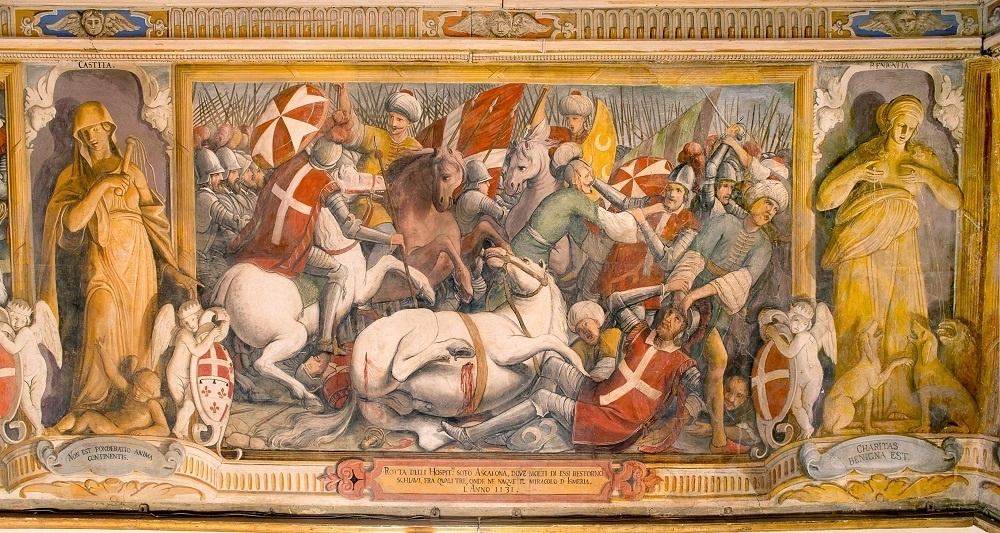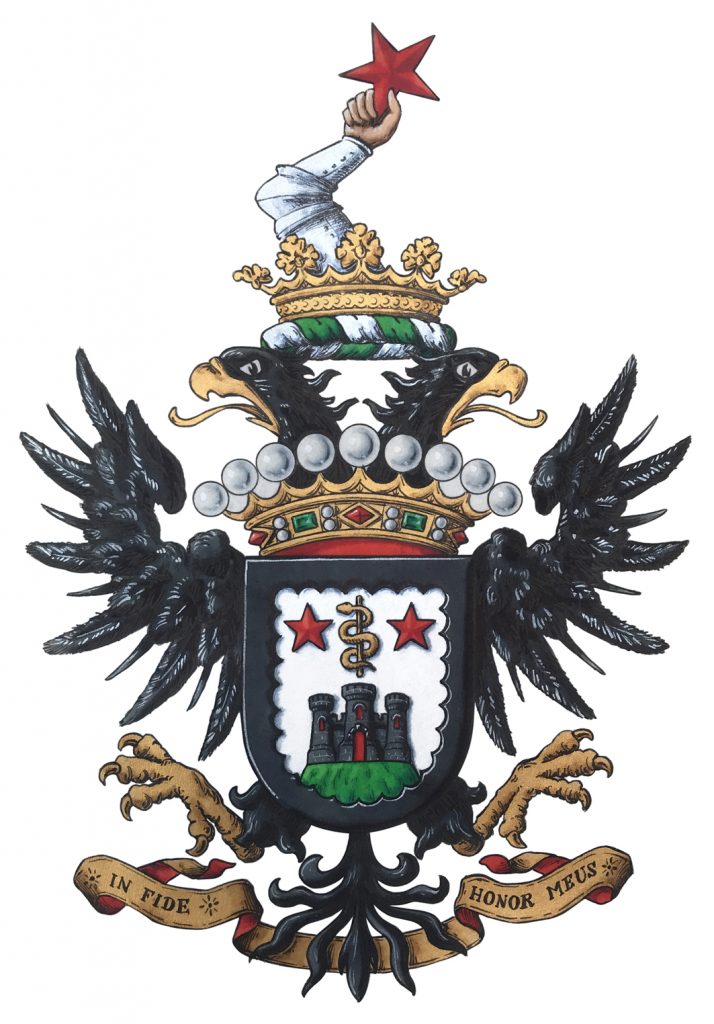
What is Heraldry?
In its narrowest sense, Heraldry is simply the insignia of identification. However, with the passage of time, the term has come to encompass the design, display and study of armorial bearings or coats of arms. Heraldry originated in the form we know it today in the second quarter of the 12th century, when it was essential to identify combatants on the battlefield, encased as they were in similar suits of armour. Heraldry created the need for Heralds. Protected from any personal danger, and distinguished by a loose overgarment called a tabard, a herald would deliver messages and challenges on behalf of his sovereign or lord.
 He would have a thorough knowledge of all the coats of arms of ‘his’ realm as well as a working knowledge of those other realms. Eventually heralds acquired the right to grant coats of arms under licence from the sovereign. With the decline in the use of armour, the original purpose of heraldry was lost. But by now, it had become deeply rooted in society. Coats of Arms were granted not only to aristocrats but also to people of substance who had the need for some means of identification in times of high illiteracy.
He would have a thorough knowledge of all the coats of arms of ‘his’ realm as well as a working knowledge of those other realms. Eventually heralds acquired the right to grant coats of arms under licence from the sovereign. With the decline in the use of armour, the original purpose of heraldry was lost. But by now, it had become deeply rooted in society. Coats of Arms were granted not only to aristocrats but also to people of substance who had the need for some means of identification in times of high illiteracy.
Nowadays Heraldry is mostly a status symbol. Many people just make up their own Arms, but for the Arms to be legal they have to be granted by a proper authority, operating under a specific charter granted by the state.
Applying for a coat of Arms
 Coats of arms may be personal and hereditary, or impersonal and non-hereditary such as those belonging to banks, colleges, and corporations. With regard to personal arms, if it can be proven that these have been in unique and uninterrupted use in Malta for at least three generations by the applicant’s ancestors, those arms would be considered as part of Malta’s intangible cultural heritage and would be registered, as they stand. In other cases, the Chief Herald uses his discretion as regards registration.
Coats of arms may be personal and hereditary, or impersonal and non-hereditary such as those belonging to banks, colleges, and corporations. With regard to personal arms, if it can be proven that these have been in unique and uninterrupted use in Malta for at least three generations by the applicant’s ancestors, those arms would be considered as part of Malta’s intangible cultural heritage and would be registered, as they stand. In other cases, the Chief Herald uses his discretion as regards registration.
When considering an application for impersonal arms from any institution, the Chief Herald of Arms would need to consider, among other things, the nature of that institution, so as to ensure that it is non-controversial and generally socially acceptable; the timescale during which that institution has been in existence; the number of members that the institution possesses; and, in the case of a business, the financial position of that company.
It is a misconception that it is just Kingdoms that have their own Heraldic Institutions. Several republics also have their own state-appointed heraldic offices. These include, the Czech Republic, Ireland, Latvia, Lithuania, Poland, Portugal, the Russian Federation and Slovakia in Europe, Kenya, South Africa, Zambia, Zimbabwe and Uganda in Africa and Azerbaijan and the Philippines in Asia.
Nowadays Heraldry is mostly a status symbol. Many people just make up their own Arms, but for the Arms to be legal they have to be granted by a proper authority, operating under a specific charter granted by the state.
Maltese Heraldry
 Malta has a rich and glorious European tradition of heraldry. Apart from the coats of arms, linked to its old families, to the Order of St. John, and/or to the Church, there are armorial bearings for various companies, schools, and corporations.
Malta has a rich and glorious European tradition of heraldry. Apart from the coats of arms, linked to its old families, to the Order of St. John, and/or to the Church, there are armorial bearings for various companies, schools, and corporations.
Despite the abundance of armorial bearings all over the Maltese islands, there had never been a central authority regulating the granting of Coats of Arms until quite recently with the establishment of the Office of the Chief Herald of Arms of Malta, based at the historic Fort St Elmo in Valletta . The appointment of Dr. Charles Gauci as Chief Herald of Arms of Malta was officially announced in the Malta Government Gazette on 25 June 2019 (Notice Number 729).
All Arms granted by or registered by the Chief Herald of Arms of Malta are recognised by the State and are protected against copying by others.
It is now the Office of the Chief Herald of Arms of Malta which regulates all new heraldic emblems, both personal and impersonal, within the Maltese Islands. The Chief Herald has the power to devise and grant new arms, both personal and corporate; to register arms which have already been in use locally for many years; and to register arms previously granted by appropriate foreign authorities.
When considering an application for impersonal arms from any institution, the Chief Herald of Arms would need to consider, among other things, the nature of that institution, so as to ensure that it is non-controversial and generally socially acceptable; the timescale during which that institution has been in existence; the number of members that the institution possesses; and, in the case of a business, the financial position of that company.
It is a misconception that it is just Kingdoms that have their own Heraldic Institutions. Several republics also have their own state-appointed heraldic offices. These include, the Czech Republic, Ireland, Latvia, Lithuania, Poland, Portugal, the Russian Federation and Slovakia in Europe, Kenya, South Africa, Zambia, Zimbabwe and Uganda in Africa and Azerbaijan and the Philippines in Asia.
Nowadays Heraldry is mostly a status symbol. Many people just make up their own Arms, but for the Arms to be legal they have to be granted by a proper authority, operating under a specific charter granted by the state.